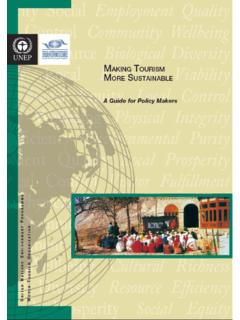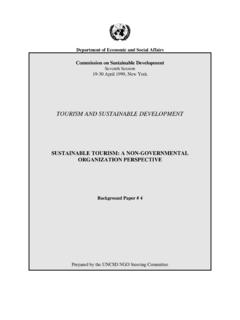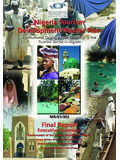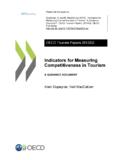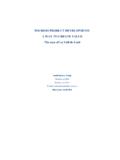Transcription of The Impacts of ourism - Minnesota Sea Grant
1 TheImpacts ofTourismBy Glenn KreagFor a tourism -based economy to sustain itself in local communities, theresidents must be willing partners in the process. Their attitudestoward tourism and perceptions of its impact on community life mustbe continually assessed. (Allen et al. 1988)The long-term sustainability of tourism rests on the ability of community leaders andtourism professionals to maximize its benefits and minimize its fact sheet tabulates 87 tourism Impacts within seven categoriesand divides the sources of tourism Impacts into tourist-basedcauses and destination-based causes. This information, whichwas distilled from recent tourism research, provides aframework for discussions, directions, and developmentregarding tourism . Formally addressing the Impacts oftourism facilitates planning that helps a communitycreate a sustainable tourism decades tourism industry growth has been amajor contributor to increased economic activitythroughout the and the world.
2 It has createdjobs in both large and small communities and is amajor industry in many places. It is the dominanteconomic activity in some communities. Yet, theimpacts of tourism to a community are not widelyunderstood even where tourism is growingdramatically and should be of the greatest interestor concern. Most people think of tourism in terms of economicimpacts, jobs, and taxes. However, the range ofimpacts from tourism is broad and often influencesareas beyond those commonly associated with as well as residents who understand the potentialimpacts of tourism can integrate this industry into theircommunity in the most positive tourism Conf lictsDifferent groups are often concerned about different tourism Impacts . To generalize,where one group embraces the e c o n o m i cimpacts of tourism , another group experiencessocial and culturali m p a c t s ,while another is affected by tourism s e n v i r o n m e n t a limpacts.
3 In theory, the interests of each group could be completely separate, as inFigure 1a. For example, Group A could include the business community and peoplewho are in need of the jobs offered by tourism . Group B might include residents whofeel displaced by an influx of visitors. Group C could be local outdoor enthusiastsconcerned about changes in natural resources. In such a case, each group would haveThe Impacts of tourism can be sorted into seven general categories:1. Economic2. Environmental3. Social and cultural4. Crowding and congestion5. Services6. Taxes 7. Community attitudeEach category includes positive and negative Impacts . Not all Impacts are applicable toevery community because conditions or resources differ. Community and tourismleaders must balance an array of Impacts that may either improve or negatively affectcommunities and their residents. Leaders must be sensitive and visionary, and mustavoid the temptation of glossing over certain difficulties tourism development leaders must also balance the opportunities and concerns of all communitysectors by working against conditions where positive Impacts benefit one part of thecommunity (geographic or social) and negative Impacts hurt , community sensitivity to tourism means avoiding undue burdens on theindustry that could thwart its success.
4 Local leaders should not expect tourism to solveall community problems. tourism is just one element of a community. While creativestrategic development of tourism amenities and services can enhance the communityor correct local deficiencies, tourism , like all business development, must assure thatits products (attractions and services) attract customers. Overbearing rules andrestrictions, and overburdening taxes can make tourism businesses less attractive different outlookson tourism . Ideally, all groupscould be positively affected andwould support the community stourism efforts. However, whengroup interests are divergent,differing perspectives canmake consensus on tourismdevelopment most cases, groups withinterests in one area of tourismwill also have interests orconcerns about other tourismimpacts as diagramed in Figure1b. In these situations, thereare common areas of interestand a greater likelihood thateach group will show moreappreciation for the concerns ofthe other groups.
5 Findingcommonality provides a startingpoint for resolving plans and actions canincrease tourism s benefits ordecrease the gravity of a negative impact . It is important for communities to understandthe wide scope of Impacts and endeavor to agree on what positive Impacts toemphasize. It is wise to acknowledge and identify possible negative Impacts so actionscan be taken to minimize or prevent them. A clear statement of the community's visionof tourism should be an integral part of a community s comprehensive plan. Activeplanning directs tourism toward the goals of the community, clarifying tourism s roleand uniting multiple Role of PlanningFigure 1. Interest in tourism ImpactsGroup CEconomicImpactsEnvironmentalImpactsSoci al & CulturalImpactsEconomicImpactsEnvironmen talImpactsSocial &CulturalImpactsGroup AGroup CGroup BGroup AGroup B4 tourism ImpactsA goal of developing the tourism industry in a community is maximizingselected positive Impacts while minimizing potential negative , it is essential to identify the possible Impacts .
6 To u r i s mresearchers have identified a large number of Impacts . Groupingthe Impacts into categories shows the types of Impacts that couldresult from developing tourism in a community. The followingtables list a range of important tourism Impacts in a conciseformat. Readers needing additional information about specificimpacts should contact appropriate professionals or consulttourism texts and research community will not experience every impact . Some aredependent on particular natural resource features (mountains,coral reefs) or development and spatial patterns (special"tourist zones"). Others relate to the social condition of thec o m m u n i t y, particularly the ability to culturally or socially connectwith tourists. Still others relate to types and intensity of tourismdevelopments, , approval or hostility toward tourist following tables are extensive but not all-inclusive.
7 Planning is not enough. Active implementation and management of plans and promptattention to emerging tourism issues will maximize positive and minimize negativeimpacts. Monitoring and addressing community attitudes should be an ongoing partof the management effort. Good monitoring efforts can identify trouble areas and giveleaders an opportunity to defuse community reactions and make timely changes beforea crisis occurs. Unfortunately, few communities are so proactive. 5 Understanding that tourism development may result in many and complex impactssuggests that local elected officials, the tourism industry, and community residentsneed to work cooperatively and carefully to plan for its growth and can help create an industry that enhances a community with minimal costsand disruptions in other aspects of community life. Having broad communityinvolvement and embracing different perspectives during planning helps identify andresolve concerns that would otherwise create problems increases employment opportunities.
8 Additional jobs, ranging from low-wageentry-level to high-paying professional positions in management and technical fields,generate income and raise standards of living. Particularly in rural areas, thediversification created by tourism helps communities that are possibly dependent ononly one industry. As tourism grows, additional opportunities are created for investment,development, and infrastructure spending. tourism often induces improvementsElaboration of tourism ImpactsECONOMIC wIncreases price of goods and serviceswIncreases price of land and housingwIncreases cost of livingwIncreases potential for imported laborwCost for additional infrastructure(water, sewer, power, fuel, medical, etc.)wIncreases road maintenance and transportation systems costswSeasonal tourism creates high-risk, under- or unemployment issueswCompetition for land with other (higher-value) economic useswProfits may be exported by non-local ownerswJobs may pay low wageswContributes to income and standard of livingwImproves local economywIncreases employment opportunitieswImproves investment, development, andinfrastructure spendingwIncreases tax revenueswImproves public utilities infrastructurewImproves transport infrastructurewIncreases opportunities for shoppingwEconomic impact (direct, indirect,induced spending) is widespread in thecommunitywCreates new business opportunities6in public utilities such as water, sewer, sidewalks, lighting, parking, public restrooms,litter control, and landscaping.
9 Such improvements benefit tourists and residentsalike. Likewise, tourism encourages improvements in transport infrastructureresulting in upgraded roads, airports, public transportation, and non-traditionaltransportation ( , trails). tourism encourages new elements to join the retail mix,increasing opportunities for shopping and adding healthy competitiveness. It oftenincreases a community's tax revenues. Lodging and sales taxes most notablyincrease but additional tax revenues include air travel and other transportationtaxes, business taxes, and fuel taxes. New jobs generate more income taxrevenues. When considering the economic Impacts of tourism , it is essential tounderstand that tourism businesses often include a significantnumber of low-paying jobs, often at minimum wage or less. T h e s ejobs are often seasonal, causing under-employment or unemploy-ment during off-seasons.
10 Labor may be imported, rather thanhired locally, especially if particular skills or expertise is required,or if local labor is unavailable. Some tourism -related businessesare volatile and high-risk ventures that are demand for goods, services, land, and housing mayincrease prices that in turn will increase the cost of businesses may claim land that could have higher- v a l u eor other uses. Additionally, non-local owners and corporationsmay export profits out of the community. The community mayhave to generate funds (possibly through increased taxes) tomaintain roads and transportation systems that have becomemore heavily used. Similarly, if additional infrastructure (water,s e w e r, power, fuel, medical, etc.) is required, additional taxes mayalso be needed to pay for with high-value natural resources, like oceans, lakes, waterfalls,mountains, unique flora and fauna, and great scenic beauty attracttourists and new residents (in-migrants) who seek emotional and spiritualconnections with nature.
